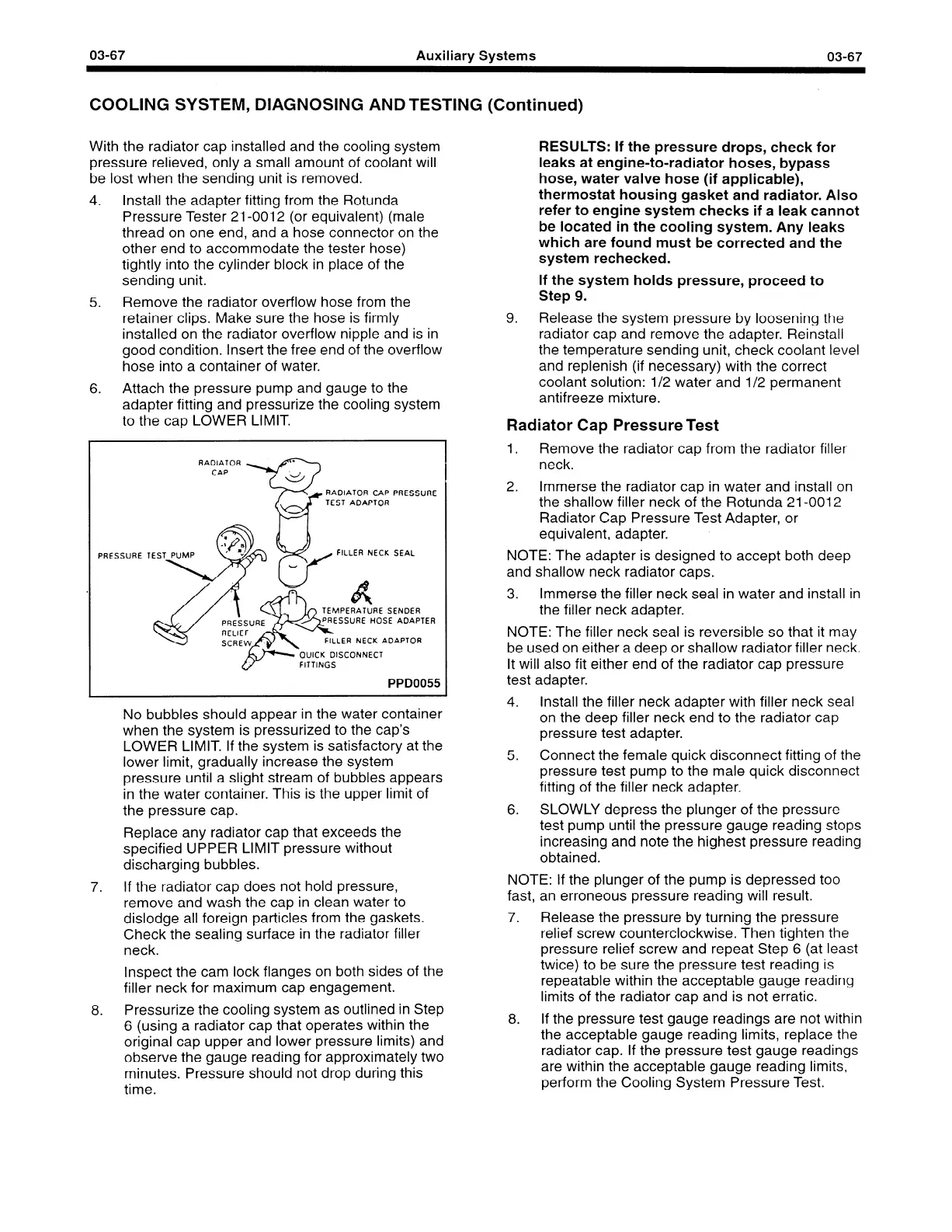03-67
Auxiliary Systems
03-67
COOLING SYSTEM, DIAGNOSING AND TESTING (Continued)
With the radiator cap installed and the cooling system
pressure relieved, only a small amount of coolant will
be lost when the sending unit is removed.
4. Install the adapter fitting from the Rotunda
Pressure Tester 21-0012 (or equivalent) (male
thread on one end, and a hose connector on the
other end to accommodate the tester hose)
tightly into the cylinder block in place of the
sending unit.
5. Remove the radiator overflow hose from the
retainer clips. Make sure the hose is firmly
installed on the radiator overflow nipple and is in
good condition. Insert the free end of the overflow
hose into a container of water.
6.
Attach the pressure pump and gauge to the
adapter fitting and pressurize the cooling system
to the cap LOWER LIMIT.
RADIATOR
CAP
RADIATOR CAP PRESSURE
TEST ADAPTOR
FILLER NECK SEAL
OUICK DISCONNECT
&- FITTINGS
PPD0055
No bubbles should appear in the water container
when the system is pressurized to the cap’s
LOWER LIMIT. If the system is satisfactory at the
lower limit, gradually increase the system
pressure until a slight stream of bubbles appears
in the water container. This is the upper limit of
the pressure cap.
Replace any radiator cap that exceeds the
specified UPPER LIMIT pressure without
discharging bubbles.
7.
If the radiator cap does not hold pressure,
remove and wash the cap in clean water to
dislodge all foreign particles from the gaskets.
Check the sealing surface in the radiator filler
neck.
Inspect the cam lock flanges on both sides of the
filler neck for maximum cap engagement.
8. Pressurize the cooling system as outlined in Step
6 (using a radiator cap that operates within the
original cap upper and lower pressure limits) and
observe the gauge reading for approximately two
minutes. Pressure should not drop during this
time.
RESULTS: If the pressure drops, check for
leaks at engine-to-radiator hoses, bypass
hose, water valve hose (if applicable),
thermostat housing gasket and radiator. Also
refer to engine system checks if a leak cannot
be located in the cooling system. Any leaks
which are found must be corrected and the
system rechecked.
If the system holds pressure, proceed to
Step 9.
9.
Release the system pressure by loosening the
radiator cap and remove the adapter. Reinstall
the temperature sending unit, check coolant level
and replenish (if necessary) with the correct
coolant solution: l/2 water and l/2 permanent
antifreeze mixture.
Radiator Cap Pressure Test
1. Remove the radiator cap from the radiator filler
neck.
2. Immerse the radiator cap in water and install on
the shallow filler neck of the Rotunda 21-0012
Radiator Cap Pressure Test Adapter, or
equivalent, adapter.
NOTE: The adapter is designed to accept both deep
and shallow neck radiator caps.
3. Immerse the filler neck seal in water and install in
the filler neck adapter.
NOTE: The filler neck seal is reversible so that it may
be used on either a deep or shallow radiator filler neck.
It will also fit either end of the radiator cap pressure
test adapter.
4. Install the filler neck adapter with filler neck seal
on the deep filler neck end to the radiator cap
pressure test adapter.
5.
Connect the female quick disconnect fitting of the
pressure test pump to the male quick disconnect
fitting of the filler neck adapter.
6.
SLOWLY depress the plunger of the pressure
test pump until the pressure gauge reading stops
increasing and note the highest pressure reading
obtained.
NOTE: If the plunger of the pump is depressed too
fast, an erroneous pressure reading will result.
7.
Release the pressure by turning the pressure
relief screw counterclockwise. Then tighten the
pressure relief screw and repeat Step 6 (at least
twice) to be sure the pressure test reading is
repeatable within the acceptable gauge reading
limits of the radiator cap and is not erratic.
8.
If the pressure test gauge readings are not within
the acceptable gauge reading limits, replace the
radiator cap. If the pressure test gauge readings
are within the acceptable gauge reading limits,
perform the Cooling System Pressure Test.

